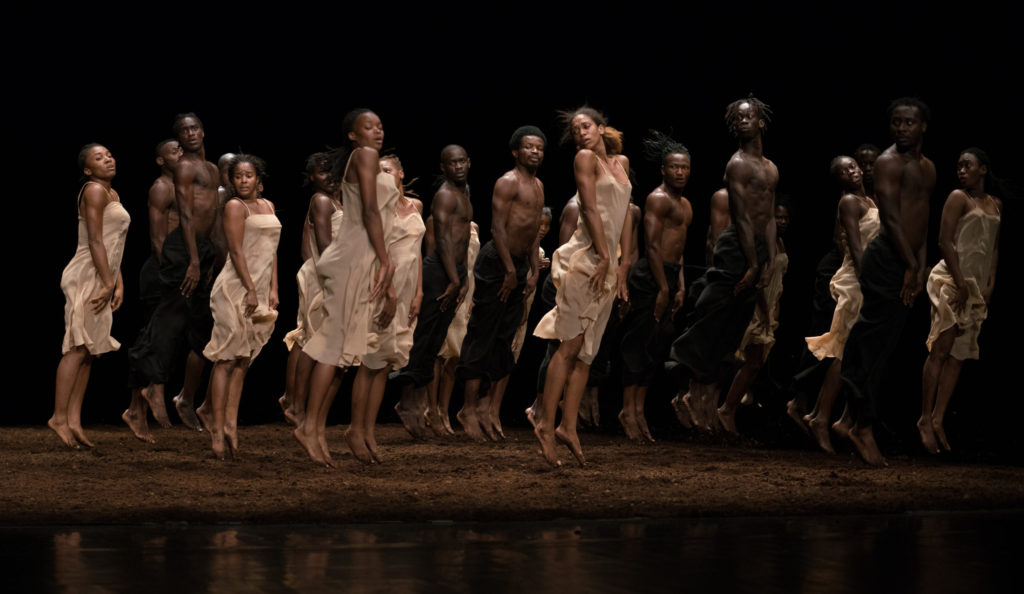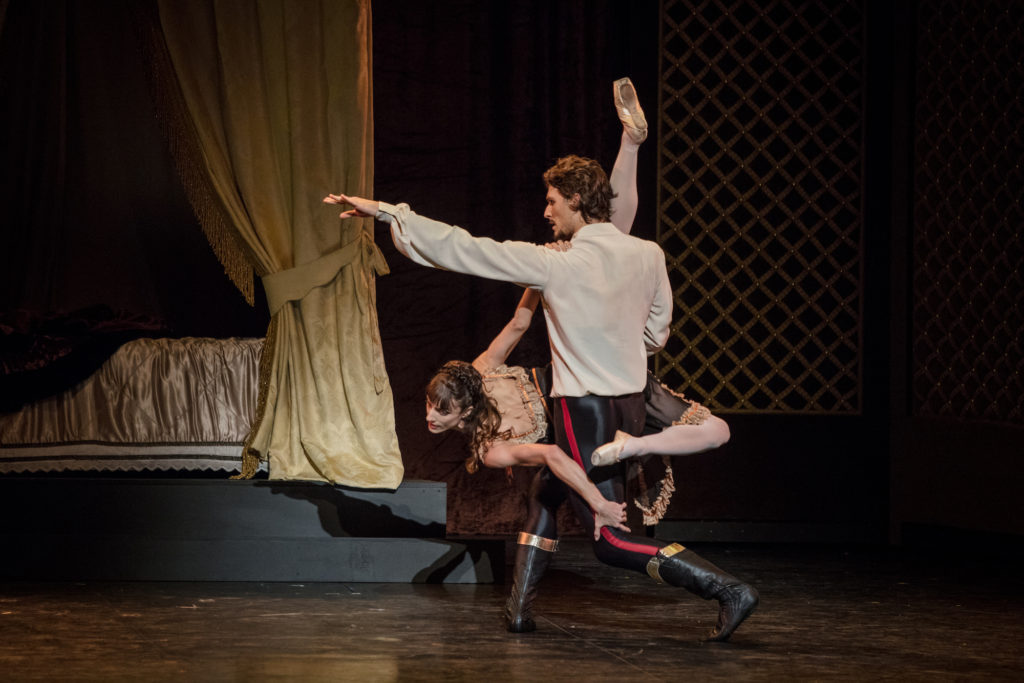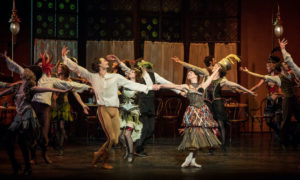Paris in the Fall: Busy, bold - Vancouver Ballet Society
- Home
- City Reports 2020 - 2023
- Paris in the Fall: Busy, bold

By Marisa C. Hayes
“How would you dance if you knew you were going to die?” asked Pina Bausch in 1975 while choreographing her expressionist The Rite of Spring. Now a cast of dancers from 14 African nations explores the same question amid the backdrop of an ongoing pandemic that grounded their international tour in 2020. Rescheduled here in September by Théâtre de la Ville at La Villette, the production is a collaboration between Senegal’s foremost dance centre, l’École des Sables, and Germany’s Pina Bausch Foundation.
The accomplished 38-member ensemble trembled and prostrated themselves to Stravinsky’s fervent orchestral composition, faithfully rendering Bausch’s sacrificial rite that concludes with a Chosen One who dances herself to death. Glistening with sweat highlighted by traces of the peat that covered the stage, relentless circular runs became a whirl of pulsing dread. Cape Verdean Luciény Kaabral, who performed the Chosen One with the feverish intensity the role requires, donned the red identifying shift and flung her arms to the sky, convulsing to the music’s final percussive strains.

Dancers of diverse training and cultural backgrounds than those typically found at Bausch’s Tanztheater Wuppertal unlocked fresh nuances and points of entry into the choreographer’s nearly 50-year-old Rite. The pan-African cast’s highly articulate backs and the powerful gravitational force of their arms generated a dynamic tension with the lower body. Their isolations, omnipresent in dance traditions across the African continent, created rich connections to the polyrhythmic score.
Haunting performances continued in September at the second annual Excentriques, a five-day festival held at La Briqueterie – National Choreographic Development Centre on the outskirts of Paris. Forms of absence — from animal extinction to demolished architecture — and what they might mean for our future were at the heart of this edition dedicated to ghosts. Bryana Fritz’s interactive Begin was a process-oriented solo in which the choreographer talked, sang, and walked the audience through her research focused on medieval women known as Beguines (think progressive, sometimes mystical, convent life without the vows).
Fritz’s ingenuity lies in her ability to activate our imagination of place, informally shepherding the public among architectural shapes delineated by coloured tape on the floor. These broad outlines of a wall and other spaces provided a makeshift blueprint for a Parisian Beguine order that, although long gone, continues to generate discussions on community, conformity, and gender.

Following Fritz’s studio showing, Dalila Belaza premiered her solo, Figures, in La Briqueterie’s main theatre. Emerging from a dimly lit stage, the dancer was entirely cloaked in a dark sculptural garment (crafted by Jean Vicérial) that eschews any recognizable form. Belaza slowly glided downstage as various sections of fabric bulged and undulated beneath the layered drapery in which she remained for much of the performance. Sabine Charreire’s sublime lighting is an integral part of the choreography, pouring over the stage in gentle waves, light travelling alongside the dancer in otherworldly patterns and shades of intensity.
Belaza notes in her artist’s statement that she sought to create a traditional dance without origins, a ritual without a past. The resulting spectral movements are a refreshing departure from figurative representation that draw on the body’s capacity to transform, a powerful metaphor for our anthropocentric era. Figures is a piece that takes its time yet inspires repeated viewings for its multifaceted movements.

The Paris Opera Ballet opened its season without a Director of Dance after Aurélie Dupont’s unexpected resignation in the summer, with her replacement just announced — José Martinez, a former POB étoile. Following his retirement from the Parisian stage in 2011, Martinez directed the Compañía Nacional de Danza in his native Spain for eight years and worked internationally as a choreographer. His appointment as Director of Dance officially begins on December 5, at which point he may begin to reassess the company’s repertoire, according to recent interviews.
Dupont’s presence lingered in the bold programming choices this fall, including a commission by Alan Lucien Øyen. In Cri de Coeur, the Norwegian dance-theatre maker proposed a family drama (containing more spoken dialogue than we’ve ever heard from the company) packaged in cardigan sweaters and complex rotating sets.
While relationships and death remained the focus of the script, Paris Opera dancers adept in the contemporary repertoire, including Marion Barbeau and Takeru Coste, collaborated with Øyen to create the less successful choreography. The result is murky at best, with meandering extensions and pivoting hips that display the dancers’ flexibility while remaining disconnected from the text and décor. It’s a far cry from Øyen’s moving duo and Carolyn seen at the Paris Opera two years ago. If the three-hour production wasn’t a choreographic success, it was a brave undertaking for the company.

Paris Opera Ballet’s second fall program was an ambitious addition to the repertoire, Kenneth MacMillan’s 1978 Mayerling. The neoclassical melodrama is based on the sexual exploits and suicide pact of Austrian Crown Prince Rudolf. Programmed concomitant to the Royal Ballet’s run of the same ballet at London’s Royal Opera House — one of their signature works — the Paris Opera was inconsistent in its mastery of MacMillan’s style on opening night. Some dancers dove into the ballet’s sensual geometric contortions with brio, including Dorothée Gilbert, Hannah O’Neill, and Marc Moreau, while the corps de ballet and première danseuse Silvia Saint-Martin appeared hesitant and laboured.

At its best, MacMillan’s choreography is dazzling in its use of soaring pas de deux composed of unexpected asymmetrical shifts in height and direction. At its worst, there is much filler, including the 19th-century tavern scene where jostling beer mugs and corseted flirtations were dull and languid. The scene was saved only by Valentine Colasante’s playful performance as Rudolf’s mistress, Mitzi Caspar. While there was room for improvement during the company’s multi-week run, Hugo Marchand was already a consummate Prince Rudolf on opening night. His interpretation leaned more toward tragic than the real-life nobleman’s morbid machinations, but the étoile appeared confident in his technical and artistic choices.

